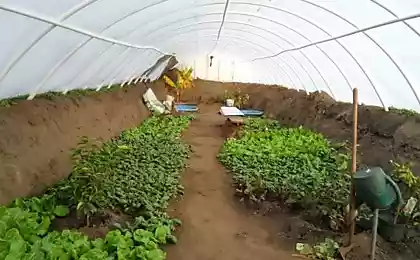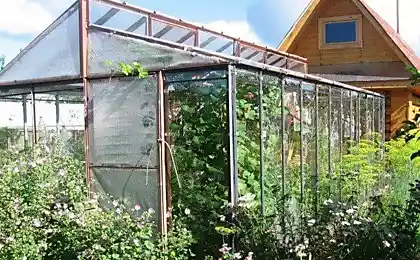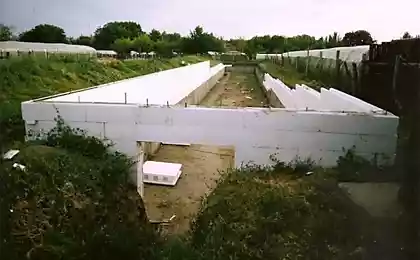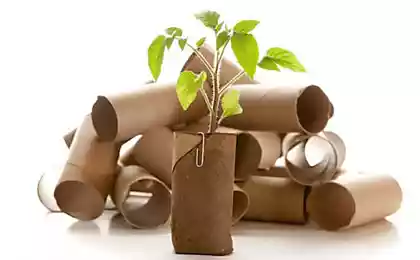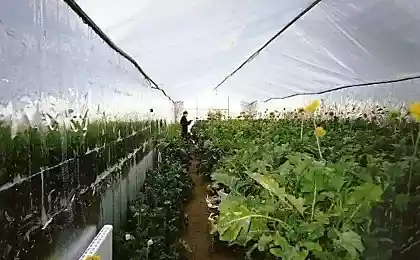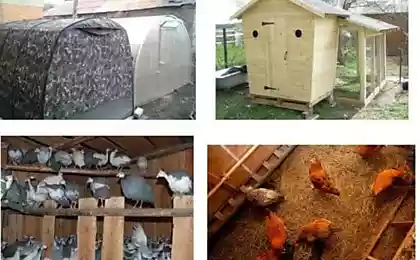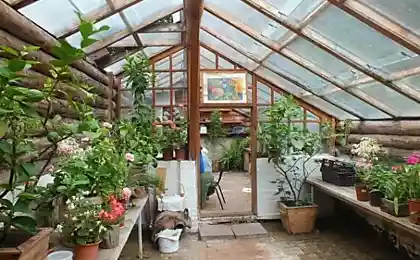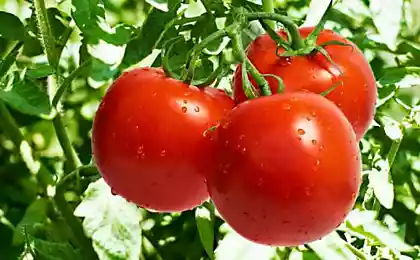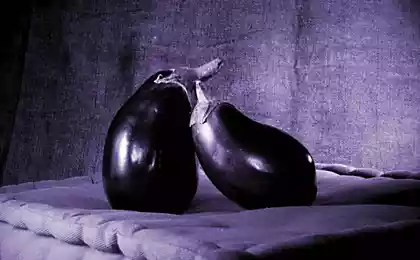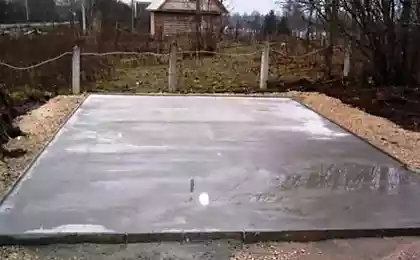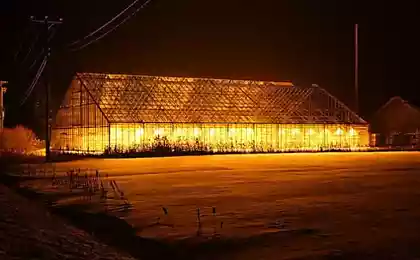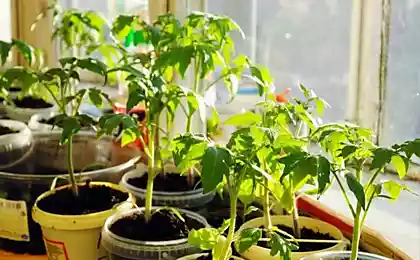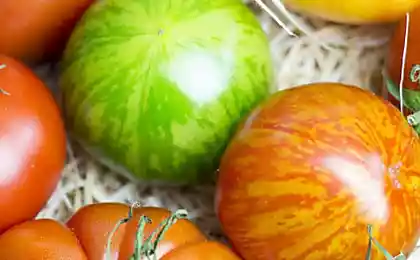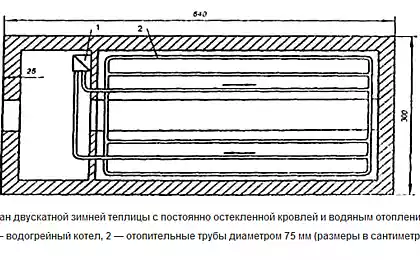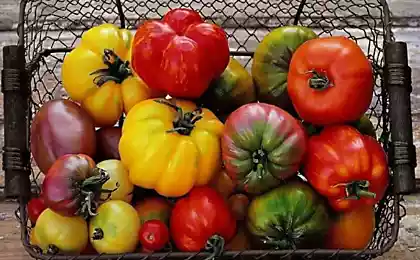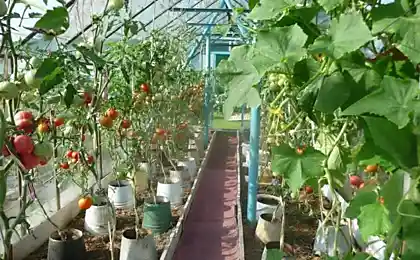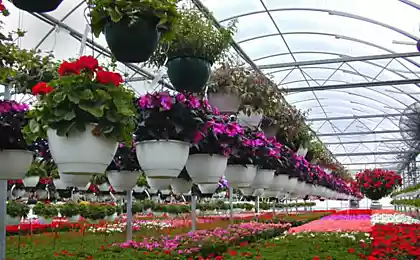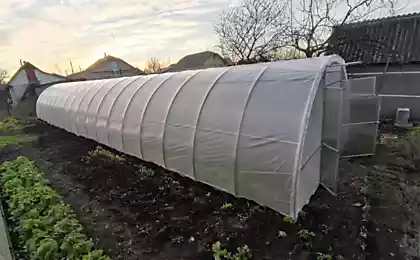547
How to grow tasty and healthy tomatoes, creating a living soil in a greenhouse
Tomatoes in the greenhouse I grow every year for more than 40 years. Have tried most of the described classical recommendations. But all the problems with their help, to solve without success.
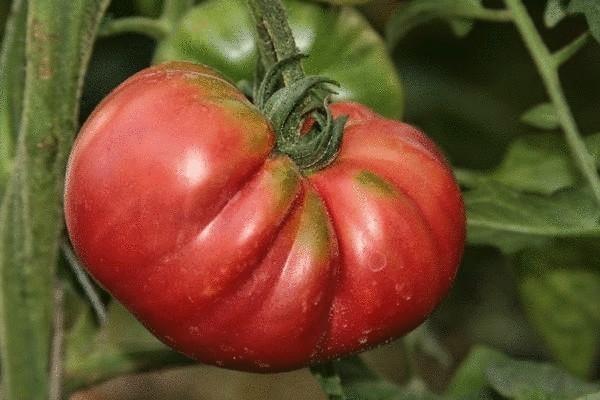
A delicious tomato from Italy, pontano, to pounds weight
Seedlings in our non-Chernozem zone in the greenhouse, it is desirable to plant early in may, to June (ie a month earlier than in open ground) to have ripe tomatoes. However, in may the soil in the greenhouse is very coldin some winters the ground is frozen up to a meter in depth and thaws slowly.
Snow in the greenhouse much not fill. Include with APR heaters uneconomical and inconvenient. The most reasonable – to make a warm high ridgesusing to heat the manure and other organic matter. The way I did.
But! Pereprava and nitrogen-rich organic matter provides the soil with this substance in excess. For cucumbers it is sometimes tolerated, but the tomatoes and peppers, and eggplant, most greenhouse owners suffer from it. Delayed onset of flowering, curl the leaves, early there fungal diseases and rot. It turns out that planting the seedlings in early may, we received the first fruits in July.
Several years ago I made three polycarbonate greenhouses and in practice, have learned some of the advantages of this material. So that was my first self-made construction
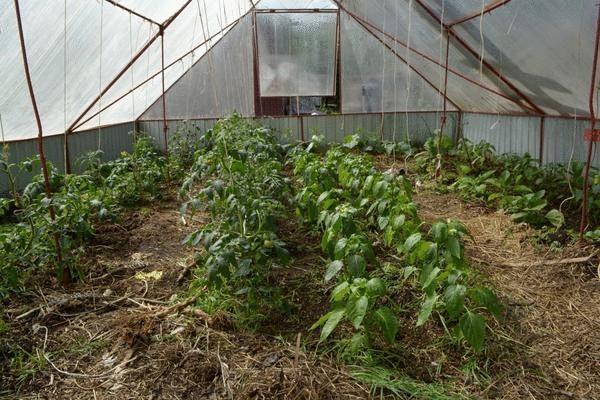
In winter Sunny days, the air in these greenhouses warms up above 20 degrees, even if the street is cold for – 20. If the winter to put a couple heat lamps, the carbonate warm rays of the holds, and the air is not cooled even in very cold nights. The last years I'm in greenhouses in winter, keep the birds — chickens and turkeys. All of our cold bird survived.
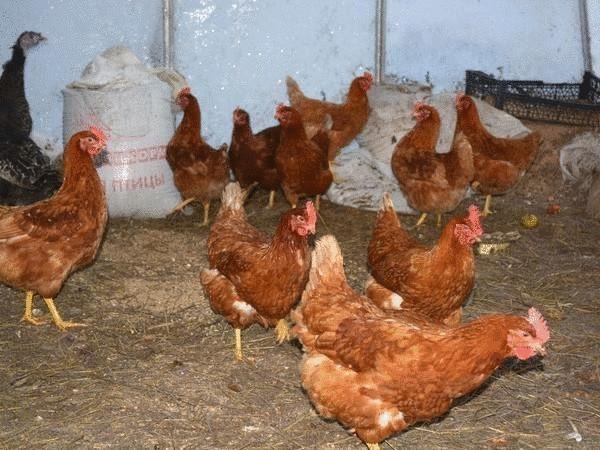
On the street at minus 20, polycarbonate covered with frost, and the rabbit litter warm.
It is also important that it saves grain and feed. Litter from goats and rabbits every day I pour a little birds that loosen it, collecting seeds. So all winter the soil in the greenhouse warm and loose. The spring layer litter manure with hay and straw I have increased to 30 cm.
In early April, bird from the greenhouse is transferred to cages, litter collected in small heaps, where she quickly warms up to +70 degrees. During the week the released ammonia sterilizes the walls of the greenhouse (mites and whiteflies after this happens).
And in this year after April 20, the compost is ripe, and I'm taken to the garden. The soil temperature at a depth of 15 cm was above 17 degrees, so I was able to plant seedlings of heat-loving crops.
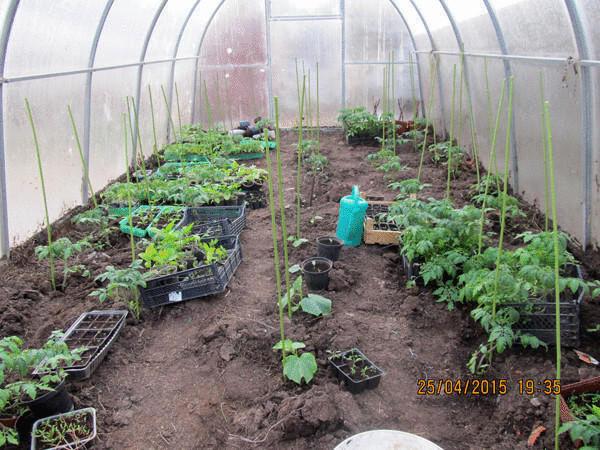
Seedlings of tomatoes and three cucumbers planted this year on April 25. The soil clean of loose after removing chicken litter, not dug up. And the next photo — summer last year in the greenhouse growing aubergines, peppers, cucumbers, planted may 10; here are constantly brewed academic hours:
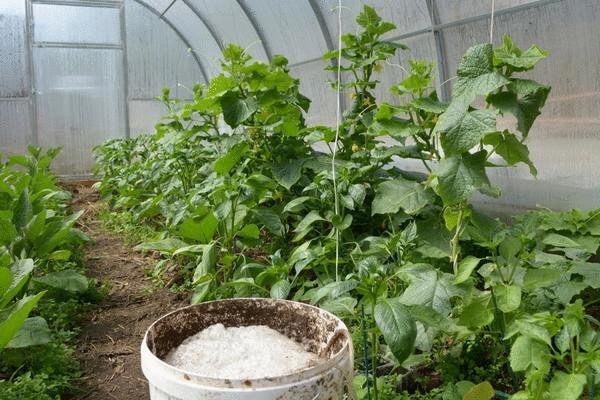
This time we'll talk about my experience of growing tomatoes in a greenhouse without digging and shifting of the soil after the winter hens.
Tomato good for health of all members of my family. We love to grow, and we grow it without pesticides. It is cheaper and tastier than in the supermarket. It contains a lot of lycopene, which protects us from illness better than any pills.
Gardening is entertaining and less time consuming, if you learn the biological methods to protect tomatoes from diseases and pests and will begin to apply organic methods to operate the soil.
Since the beginning of August, many are killed to 80% of the harvest of tomatoes from Phytophthora. Out — in observance of five rules:
How do I choose the varietiesFor the greenhouse I chose varieties of two types. First, the hybridsthat will Mature on the branches until October without diseases, and then to lie on the balcony before the new year. Taste worse, but the pain was still there, and no pesticides.
And second, be sure to drop Amateur-grade type of beef heart, which can grow to a kilogram in weight and which differ from the hybrids of extraordinary taste.
In recent years I seeds barbotine in academic hours. Add to 0.5 liters of water 5% of vermicompost or old compost (useful aerobic organisms), 0.5% of sweet molasses (molasses), signed placed the seeds in baggies in the solution and day breathable aquarium compressor. All surface pathogens wash off, eat them reproducing exponentially beneficial soil organisms and the germ seed begins to flourish, the scent of spring. After all, in the soil, that the first thunderstorm of spring is saturated with oxygen and moisture, in the same way awaken the microorganisms and stimulate the awakening of the dormant seed.
As I grow seedlingsSeeds in containers planted with the stock. When they grow up, pull out and throw out all the backward — so get rid of the viruses. Pull out all upstarts, growing above all — so it's the regrading.
Three dangers lurk sprouts in the first week of growth.
First — when in random soil no available phosphate salts. 7 days after germination showed that both lanceolate leaf of the sprout pointing upward at an acute angle, and the first two true leaves pressed against one another and have small dimensions. All the plates with the underside purple-red, with upper — normal color. With a good provision of phosphorus lanceolate leaves (cotyledons) are arranged horizontally or down. The lower side has the usual green color. The first pair of true leaves opened. If you do not water the seedlings immediately, in the future it will not give good harvest.
Second problem burn seedlings by excess water, which is poorly mixed with the soil. Shoots turn yellow and die.
A terrible trouble – fungal rot in the infected soil.
The best seedlings for planting in the ground, stocky, not older than 35-40 days. And plan its growth.
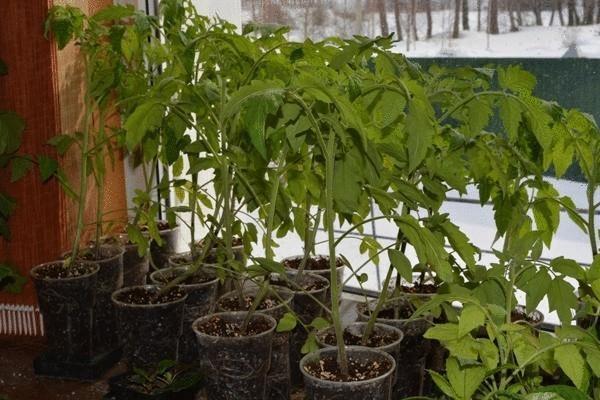
Places to seedlings in March is never enough.
Getting a hard-on seedlings in the phase sheet of the present in bags of delicate nonwoven (spunbond). The amount of soil — about a liter. Put on a tray and watered from the bottom, fed from the top. Aeration in these bags of a fabric is gorgeous, and in plastic glasses that are given, it will desiccate.
Planted seeds in three terms — from mid-February to mid-March: early greenhouses for Amateur and large for open ground. Have a reserve in case of disasters.
Create the conditions for seedlings! I do not believe that the secret is in the breed and feeding. The main thing — the light and warmth on your window sills. At first the bright sun will burn everything. In cloudy weather without light will stretch. At a high temperature to grow, will weaken; in cold soil will sour and rot. Watch, organize, not thickening the windowsill. Less – so stocky.
The most labor-intensive agricultural method which gives a 30% yield increaseis the removal of the seedlings on the street in the last week before planting in the greenhouse or in the ground. Plants must be accustomed to the air and sun. In a week the sheet is a dense, emerald-green from chlorophyll, the stem is strong. I accustom the seedlings to the air since March, in Sunny days:
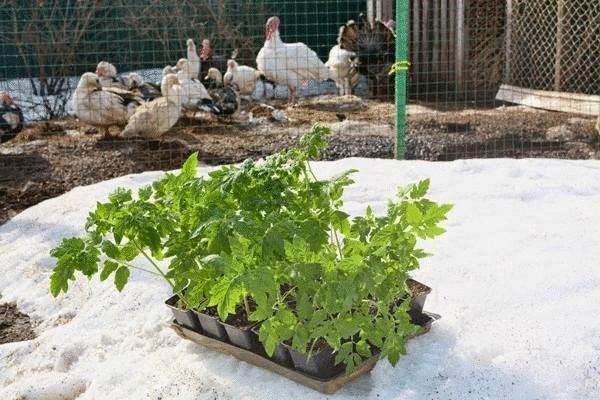
Weak seedlings sore for up to two weeks and is hardened in growth immediately after planting. All my pallets from the porch to stand and put on the South side of the house. At night I bring home, if you promise a cold night.
If the seedlings are in opaque plastic pots, check the moisture content at a depth of: if dry, should be watered in the morning, otherwise the wind will dry the soil and destroy plants. Conversely, in the cold on the window sill transfused seedling rot. In the morning I poured into a tray water and bags of soil it is gradually absorbed.
Proper nutrition for seedlingsYou planted tomatoes in the greenhouse. Observe the growth of young upper leaves in a week. If the top leaves are oily, brittle and curl is the worst: overfeeding with nitrogen. Need a good ground to shed, to wash nitrates, feed with sulphate of potash in a dual norm and cover with layer of fresh sawdust with a thickness of 5 cm They will take away excess nitrogen. A couple of weeks to remove sawdust. If extra nitrogen in early flowering is not removed, the brush will not begin, and fruiting will be postponed for a fortnight.
If the plant is stunted, the lower leaves turn yellow and the soil is not cold and not filled is the lack of nitrogen. It is eliminated easily. Nitrogen fertilizer in liquid form it is better to use organic feeding. Pour the warm a couple of times a weak (half) solution over mulch and organic matter with a sufficient nitrogen content.
Deficiency of potassium and micronutrients before flowering usually does not occur. It will be then — when ripening, but the lack of phosphorus it is necessary to recognize: if the plant turns purple (bottom side of the leaves, stems, veins on leaves) once to feed any liquid phosphorus fertilizer.
Don't be afraid to use weak solutions of quality mineral fertilizers in the early growth of plants. That's when the fruit will be poured, then the advice to pour in the ground mineral water be careful.
I don't use modern complex liquid fertilizer with amino acids and stimulants (Brexil, Master and the like). Leave that to the Chinese greenhouse owners. In my soil with old compost shed academic hours, of stimulants, which gives the roots of the biota, more than enough.
Threat the lack of calcium. It is usually combined with overfeeding with nitrogen and potassium deficiency. The fruits swell quickly, and you receive the apical rot. Treatment one: the roots watered magnesium and potassium fertilizers, and fruits and leaves a couple of times to spray calcium nitrate.
How to create a plantdelay with the removal of laterals very harmful effect on the crop, the shoots form a powerful side branches, which consumed a lot of nutrients. The Bush begins to branch out and delay growth and development of fruit buds.
Stepchildren must be removedwhen they grow to 3-4 cm, leaving stumps. Don't listen to the advisors that the lower shoots should tilt to the implant. We do not Kuban. We limit short summer. Our main reserve – the reserve stocky seedlings and forming plants 3 to 5 brushes in soil or up to 7 brushes in the greenhouse. And we planted the seedlings always with blooming brush.
In the greenhouse seedsi-determinate varieties , you can grow 2-3 stems, leaving the first flower stepson under the first brush, and another a little higher up, under the second flower with a brush. It is necessary to look at the quality stepchildren: which is thicker — the left, the rest all removed. Sometimes these varieties verschatse (instead of leaves on top it grows the brush) on the third brush, and you continue the trunk of the left lower laterals.
Indeterminate varieties I'm only one gun, sometimes in the beginning of the first brush the barrel splits, and I'm such a plant in two guns. No games and pity stepchildren in the greenhouse are not allowed, otherwise, tall varieties did not show its yield potential.
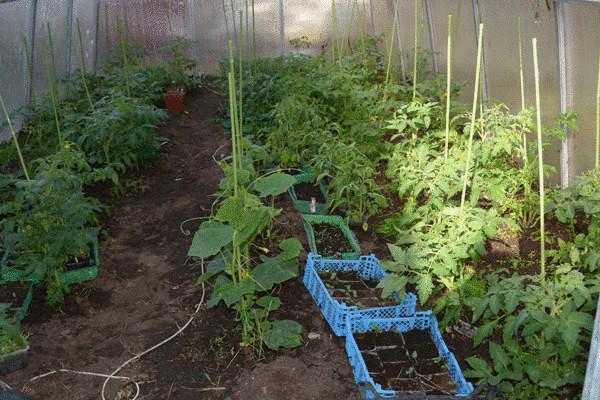
It's only been two weeks — on may 9, the greenhouse do not know. I cherry not bloomed.
I delete and unneeded tiles. Healthy, green and well-lit sheet assistant. But it has its time, its age. Old leaves often turn yellow, covered with different spots, wilt and serve as a breeding ground for disease. Therefore, they will be deleted in the first place. Usually the beginning of ripening of the first brushes I remove everything that is below. Even a healthy. Light and air are more important.
Organic or mineral water?My vast experience and expertise of ecologists around the world showed that some fertilizer when they are making uniform throughout the soil tasty and healthy tomatoes to grow fails. Mineral water inhibits the biota in the whole area of the roots, and vitamins, minerals and other biologically active substances give the roots only symbiotic microorganisms and soil animals in their secretions in the rhizosphere.
But on the contrary: the tomatoes are not growing on the same organic matter. That is, to grow-it will grow, but the taste is not the same with the nitrate problem, the crop tops are always more than the fruit. Pests and diseases from all around come to these overfed plants.
Everything is solved simply: I'm in the hole 5 cm from the stem when planting, make 3-5-7 grams (depending on the gigantism of variety) of any integrated long-lasting fertilizer for tomatoes, which is dominated by potassium and phosphorus. Better — organic Buyskiy WMD, well Kemiru or Particu.
I have in abundance are two types of mulch. There lay bags of litter manure, in which there is no available sugars and amino acids, but have all the minerals and trace elements in the bodies of soil biota. The ratio of nitrogen to carbon in it is still high, in the range of 1/30.
There are chips from twigs of deciduous trees, where on the contrary, no soil biota, the ratio of nitrogen to carbon 1/100, but a lot of sugar and lignin. This allows a mushroom-destroyers of wood is the best protection against fungal pathogens, and further attracts countless hordes of small predators, and they will loosen the earth, saturating it fresh, active humus, to create microscopic pores in the soil, making it lumpy, structural.
Constantly monitor the soil, its moisture content and porosity. Watching the plants grow — whether there is an excess of nitrogen. And as an artist by inspiration picks up paint like a chef picks up the food and spices, so I mulched the tomatoes several times over the summer, picking up doses of compost and top — dose sweet chips. And all this every 7-10 days spraying activitybuy academic hours. And then I bring in the dish for tasting your score — colorful ripe, fragrant tomatoes and sugar pomidorami.
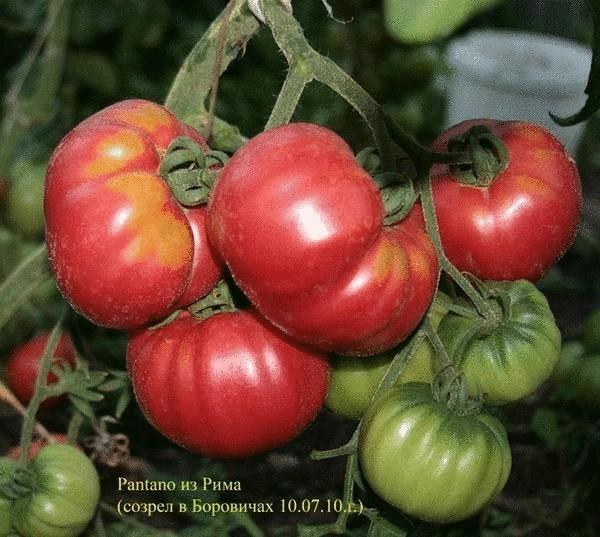
So at this time. Autumn harvested peppers, cucumbers and eggplants, the land did not dig, started in the greenhouse chickens. They all winter raked the soil and litter, warmed her. In the spring most of the nitrogen layer was removed and loose, like cotton wool, soil, planted seedlings, making the hole just by hand.
Watered with warm water and add academic hours and vermica. In places where the seedlings were stunted, superficial added a spoonful of vermicompost before watering. If the seedlings are started gorging, sprayed sheet and watered the soil with a weak solution of cristalina (for conifers) where there is little nitrogen and lots of potassium.
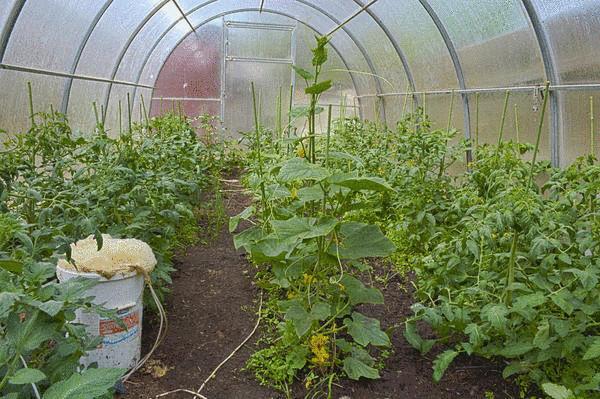
The rate of growth and flowering of seedlings this year ahead forecasts. It has been three weeks after planting tomatoes and cucumbers. Cucumbers grew more than a meter, tens of ovaries. Tomatoes — 80-90 Bloom, see more 3 hands, poured the first fruits. Of disease and imbalances of power.
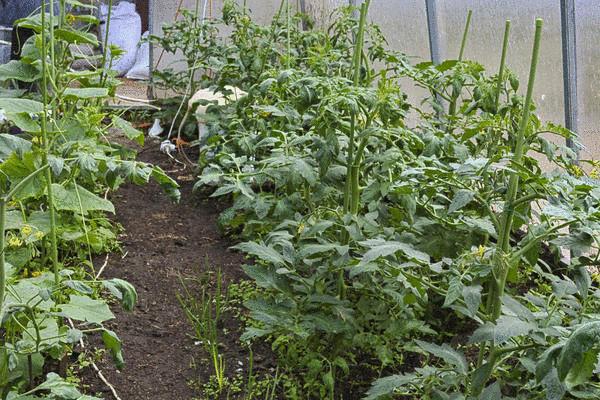
It took only 3 weeks from planting! Academic hours and chickens work wonders with the soil.
But I was grown in a greenhouse and seedlings for the street. From 15 may to large pots holding her on the street. That's what it is — chunky, with flowering tassels. May 20 is planted in the garden without any film.
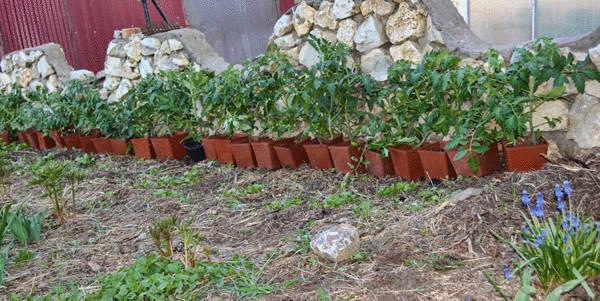
P. S. And remember, only by changing their consumption — together we change the world! ©
Source: www.7dach.ru

A delicious tomato from Italy, pontano, to pounds weight
Seedlings in our non-Chernozem zone in the greenhouse, it is desirable to plant early in may, to June (ie a month earlier than in open ground) to have ripe tomatoes. However, in may the soil in the greenhouse is very coldin some winters the ground is frozen up to a meter in depth and thaws slowly.
Snow in the greenhouse much not fill. Include with APR heaters uneconomical and inconvenient. The most reasonable – to make a warm high ridgesusing to heat the manure and other organic matter. The way I did.
But! Pereprava and nitrogen-rich organic matter provides the soil with this substance in excess. For cucumbers it is sometimes tolerated, but the tomatoes and peppers, and eggplant, most greenhouse owners suffer from it. Delayed onset of flowering, curl the leaves, early there fungal diseases and rot. It turns out that planting the seedlings in early may, we received the first fruits in July.
Several years ago I made three polycarbonate greenhouses and in practice, have learned some of the advantages of this material. So that was my first self-made construction

In winter Sunny days, the air in these greenhouses warms up above 20 degrees, even if the street is cold for – 20. If the winter to put a couple heat lamps, the carbonate warm rays of the holds, and the air is not cooled even in very cold nights. The last years I'm in greenhouses in winter, keep the birds — chickens and turkeys. All of our cold bird survived.

On the street at minus 20, polycarbonate covered with frost, and the rabbit litter warm.
It is also important that it saves grain and feed. Litter from goats and rabbits every day I pour a little birds that loosen it, collecting seeds. So all winter the soil in the greenhouse warm and loose. The spring layer litter manure with hay and straw I have increased to 30 cm.
In early April, bird from the greenhouse is transferred to cages, litter collected in small heaps, where she quickly warms up to +70 degrees. During the week the released ammonia sterilizes the walls of the greenhouse (mites and whiteflies after this happens).
And in this year after April 20, the compost is ripe, and I'm taken to the garden. The soil temperature at a depth of 15 cm was above 17 degrees, so I was able to plant seedlings of heat-loving crops.

Seedlings of tomatoes and three cucumbers planted this year on April 25. The soil clean of loose after removing chicken litter, not dug up. And the next photo — summer last year in the greenhouse growing aubergines, peppers, cucumbers, planted may 10; here are constantly brewed academic hours:

This time we'll talk about my experience of growing tomatoes in a greenhouse without digging and shifting of the soil after the winter hens.
Tomato good for health of all members of my family. We love to grow, and we grow it without pesticides. It is cheaper and tastier than in the supermarket. It contains a lot of lycopene, which protects us from illness better than any pills.
Gardening is entertaining and less time consuming, if you learn the biological methods to protect tomatoes from diseases and pests and will begin to apply organic methods to operate the soil.
Since the beginning of August, many are killed to 80% of the harvest of tomatoes from Phytophthora. Out — in observance of five rules:
- Early ripening varieties.
- Defenses.
- Seedlings with maximum running.
- Individual forming of plants for each variety.
- The fifth and most important rule: do not use organic and mineral fertilizers with high nitrogen content until the formation of the ovaries are at first hand and to conduct correction of feeding phosphorus-potassium fertilizers with microelements for symptoms of nitrogen overfeeding.
How do I choose the varietiesFor the greenhouse I chose varieties of two types. First, the hybridsthat will Mature on the branches until October without diseases, and then to lie on the balcony before the new year. Taste worse, but the pain was still there, and no pesticides.
And second, be sure to drop Amateur-grade type of beef heart, which can grow to a kilogram in weight and which differ from the hybrids of extraordinary taste.
In recent years I seeds barbotine in academic hours. Add to 0.5 liters of water 5% of vermicompost or old compost (useful aerobic organisms), 0.5% of sweet molasses (molasses), signed placed the seeds in baggies in the solution and day breathable aquarium compressor. All surface pathogens wash off, eat them reproducing exponentially beneficial soil organisms and the germ seed begins to flourish, the scent of spring. After all, in the soil, that the first thunderstorm of spring is saturated with oxygen and moisture, in the same way awaken the microorganisms and stimulate the awakening of the dormant seed.
As I grow seedlingsSeeds in containers planted with the stock. When they grow up, pull out and throw out all the backward — so get rid of the viruses. Pull out all upstarts, growing above all — so it's the regrading.
Three dangers lurk sprouts in the first week of growth.
First — when in random soil no available phosphate salts. 7 days after germination showed that both lanceolate leaf of the sprout pointing upward at an acute angle, and the first two true leaves pressed against one another and have small dimensions. All the plates with the underside purple-red, with upper — normal color. With a good provision of phosphorus lanceolate leaves (cotyledons) are arranged horizontally or down. The lower side has the usual green color. The first pair of true leaves opened. If you do not water the seedlings immediately, in the future it will not give good harvest.
Second problem burn seedlings by excess water, which is poorly mixed with the soil. Shoots turn yellow and die.
A terrible trouble – fungal rot in the infected soil.
The best seedlings for planting in the ground, stocky, not older than 35-40 days. And plan its growth.

Places to seedlings in March is never enough.
Getting a hard-on seedlings in the phase sheet of the present in bags of delicate nonwoven (spunbond). The amount of soil — about a liter. Put on a tray and watered from the bottom, fed from the top. Aeration in these bags of a fabric is gorgeous, and in plastic glasses that are given, it will desiccate.
Planted seeds in three terms — from mid-February to mid-March: early greenhouses for Amateur and large for open ground. Have a reserve in case of disasters.
Create the conditions for seedlings! I do not believe that the secret is in the breed and feeding. The main thing — the light and warmth on your window sills. At first the bright sun will burn everything. In cloudy weather without light will stretch. At a high temperature to grow, will weaken; in cold soil will sour and rot. Watch, organize, not thickening the windowsill. Less – so stocky.
The most labor-intensive agricultural method which gives a 30% yield increaseis the removal of the seedlings on the street in the last week before planting in the greenhouse or in the ground. Plants must be accustomed to the air and sun. In a week the sheet is a dense, emerald-green from chlorophyll, the stem is strong. I accustom the seedlings to the air since March, in Sunny days:

Weak seedlings sore for up to two weeks and is hardened in growth immediately after planting. All my pallets from the porch to stand and put on the South side of the house. At night I bring home, if you promise a cold night.
If the seedlings are in opaque plastic pots, check the moisture content at a depth of: if dry, should be watered in the morning, otherwise the wind will dry the soil and destroy plants. Conversely, in the cold on the window sill transfused seedling rot. In the morning I poured into a tray water and bags of soil it is gradually absorbed.
Proper nutrition for seedlingsYou planted tomatoes in the greenhouse. Observe the growth of young upper leaves in a week. If the top leaves are oily, brittle and curl is the worst: overfeeding with nitrogen. Need a good ground to shed, to wash nitrates, feed with sulphate of potash in a dual norm and cover with layer of fresh sawdust with a thickness of 5 cm They will take away excess nitrogen. A couple of weeks to remove sawdust. If extra nitrogen in early flowering is not removed, the brush will not begin, and fruiting will be postponed for a fortnight.
If the plant is stunted, the lower leaves turn yellow and the soil is not cold and not filled is the lack of nitrogen. It is eliminated easily. Nitrogen fertilizer in liquid form it is better to use organic feeding. Pour the warm a couple of times a weak (half) solution over mulch and organic matter with a sufficient nitrogen content.
Deficiency of potassium and micronutrients before flowering usually does not occur. It will be then — when ripening, but the lack of phosphorus it is necessary to recognize: if the plant turns purple (bottom side of the leaves, stems, veins on leaves) once to feed any liquid phosphorus fertilizer.
Don't be afraid to use weak solutions of quality mineral fertilizers in the early growth of plants. That's when the fruit will be poured, then the advice to pour in the ground mineral water be careful.
I don't use modern complex liquid fertilizer with amino acids and stimulants (Brexil, Master and the like). Leave that to the Chinese greenhouse owners. In my soil with old compost shed academic hours, of stimulants, which gives the roots of the biota, more than enough.
Threat the lack of calcium. It is usually combined with overfeeding with nitrogen and potassium deficiency. The fruits swell quickly, and you receive the apical rot. Treatment one: the roots watered magnesium and potassium fertilizers, and fruits and leaves a couple of times to spray calcium nitrate.
How to create a plantdelay with the removal of laterals very harmful effect on the crop, the shoots form a powerful side branches, which consumed a lot of nutrients. The Bush begins to branch out and delay growth and development of fruit buds.
Stepchildren must be removedwhen they grow to 3-4 cm, leaving stumps. Don't listen to the advisors that the lower shoots should tilt to the implant. We do not Kuban. We limit short summer. Our main reserve – the reserve stocky seedlings and forming plants 3 to 5 brushes in soil or up to 7 brushes in the greenhouse. And we planted the seedlings always with blooming brush.
In the greenhouse seedsi-determinate varieties , you can grow 2-3 stems, leaving the first flower stepson under the first brush, and another a little higher up, under the second flower with a brush. It is necessary to look at the quality stepchildren: which is thicker — the left, the rest all removed. Sometimes these varieties verschatse (instead of leaves on top it grows the brush) on the third brush, and you continue the trunk of the left lower laterals.
Indeterminate varieties I'm only one gun, sometimes in the beginning of the first brush the barrel splits, and I'm such a plant in two guns. No games and pity stepchildren in the greenhouse are not allowed, otherwise, tall varieties did not show its yield potential.

It's only been two weeks — on may 9, the greenhouse do not know. I cherry not bloomed.
I delete and unneeded tiles. Healthy, green and well-lit sheet assistant. But it has its time, its age. Old leaves often turn yellow, covered with different spots, wilt and serve as a breeding ground for disease. Therefore, they will be deleted in the first place. Usually the beginning of ripening of the first brushes I remove everything that is below. Even a healthy. Light and air are more important.
Organic or mineral water?My vast experience and expertise of ecologists around the world showed that some fertilizer when they are making uniform throughout the soil tasty and healthy tomatoes to grow fails. Mineral water inhibits the biota in the whole area of the roots, and vitamins, minerals and other biologically active substances give the roots only symbiotic microorganisms and soil animals in their secretions in the rhizosphere.
But on the contrary: the tomatoes are not growing on the same organic matter. That is, to grow-it will grow, but the taste is not the same with the nitrate problem, the crop tops are always more than the fruit. Pests and diseases from all around come to these overfed plants.
Everything is solved simply: I'm in the hole 5 cm from the stem when planting, make 3-5-7 grams (depending on the gigantism of variety) of any integrated long-lasting fertilizer for tomatoes, which is dominated by potassium and phosphorus. Better — organic Buyskiy WMD, well Kemiru or Particu.
I have in abundance are two types of mulch. There lay bags of litter manure, in which there is no available sugars and amino acids, but have all the minerals and trace elements in the bodies of soil biota. The ratio of nitrogen to carbon in it is still high, in the range of 1/30.
There are chips from twigs of deciduous trees, where on the contrary, no soil biota, the ratio of nitrogen to carbon 1/100, but a lot of sugar and lignin. This allows a mushroom-destroyers of wood is the best protection against fungal pathogens, and further attracts countless hordes of small predators, and they will loosen the earth, saturating it fresh, active humus, to create microscopic pores in the soil, making it lumpy, structural.
Constantly monitor the soil, its moisture content and porosity. Watching the plants grow — whether there is an excess of nitrogen. And as an artist by inspiration picks up paint like a chef picks up the food and spices, so I mulched the tomatoes several times over the summer, picking up doses of compost and top — dose sweet chips. And all this every 7-10 days spraying activitybuy academic hours. And then I bring in the dish for tasting your score — colorful ripe, fragrant tomatoes and sugar pomidorami.

So at this time. Autumn harvested peppers, cucumbers and eggplants, the land did not dig, started in the greenhouse chickens. They all winter raked the soil and litter, warmed her. In the spring most of the nitrogen layer was removed and loose, like cotton wool, soil, planted seedlings, making the hole just by hand.
Watered with warm water and add academic hours and vermica. In places where the seedlings were stunted, superficial added a spoonful of vermicompost before watering. If the seedlings are started gorging, sprayed sheet and watered the soil with a weak solution of cristalina (for conifers) where there is little nitrogen and lots of potassium.

The rate of growth and flowering of seedlings this year ahead forecasts. It has been three weeks after planting tomatoes and cucumbers. Cucumbers grew more than a meter, tens of ovaries. Tomatoes — 80-90 Bloom, see more 3 hands, poured the first fruits. Of disease and imbalances of power.

It took only 3 weeks from planting! Academic hours and chickens work wonders with the soil.
But I was grown in a greenhouse and seedlings for the street. From 15 may to large pots holding her on the street. That's what it is — chunky, with flowering tassels. May 20 is planted in the garden without any film.

P. S. And remember, only by changing their consumption — together we change the world! ©
Source: www.7dach.ru
In all districts of Moscow will be mobile points of reception of recyclable materials
Archeoraptor, the physics of vibrations and a mysterious toxin: 7 great scientific hoaxes
